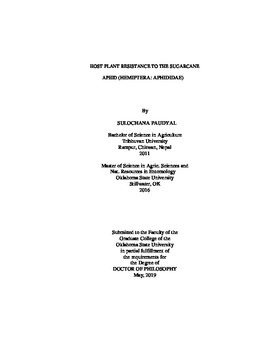| dc.contributor.advisor | Armstrong, J. Scott | |
| dc.contributor.advisor | Giles, Kristopher L. | |
| dc.contributor.author | Paudyal, Sulochana | |
| dc.date.accessioned | 2019-10-25T19:51:41Z | |
| dc.date.available | 2019-10-25T19:51:41Z | |
| dc.date.issued | 2019-05-01 | |
| dc.identifier.uri | https://hdl.handle.net/11244/321565 | |
| dc.description.abstract | The sugarcane aphid (<i>Melanaphis sacchari</i> (Zehnter) (Hemiptera: Aphididae)) has become a serious pest of sorghum (<i>Sorghum bicolor</i> (L.) Moench) in the United States since it was detected in 2013. Knowledge of the physiological response of sorghum to <i>M. sacchari</i> feeding will provide baseline information on a defined defense response and the resistance mechanisms of sorghum. This study documented the impact of <i>M. sacchari</i> feeding on resistant and susceptible genotypes through chlorophyll content, photosynthetic rate, stomatal conductance and carbon assimilation. Resistant genotypes that were infested with sugarcane aphids were able to compensate injury by either increasing or maintaining photosynthetic rate and stomatal conductance. Some resistant sorghum entries were able to tolerate the impacts of <i>M. sacchari</i> injury on photosynthetic integrity. Finding and advancing such germplasm has been a priority for sorghum breeders at the academic and industry levels. Twenty-three sorghum genotypes were selected and evaluated for resistance to <i>M. sacchari</i> by testing for tolerance, antibiosis and antixenosis. Free-choice and no-choice tests were conducted to explore the functional categories of resistance. Levels of resistance to <i>M. sacchari</i> were compared with the known resistant 'TX 2783' and susceptible 'KS 585' genotypes. Sorghum entries AG1201, AG1301, W844-E, and DKS 37-07 were identified as expressing tolerance, antibiosis, and antixenosis, while H13073 expressed antibiosis and GW1489 expressed both tolerance and antibiosis. Lastly, I examined the phenotypic behaviors (host suitability as measured through life table statistics) among the <i>M. sacchari</i> clones collected from different hosts and geographic locations. Aphid clones varied in performance among plant hosts. The survivorship and reproduction of the sugarcane collected aphid clone (SuSCA) was significantly higher when offered sugarcane (>85%) as compared to other hosts. In contrast, there was negligible survival and reproduction when sorghum collected (SoSCA) and Columbus grass collected (CoSCA) clones were offered sugarcane as host. This observation suggests that SuSCA and SoSCA are host-specific clones. | |
| dc.format | application/pdf | |
| dc.language | en_US | |
| dc.rights | Copyright is held by the author who has granted the Oklahoma State University Library the non-exclusive right to share this material in its institutional repository. Contact Digital Library Services at lib-dls@okstate.edu or 405-744-9161 for the permission policy on the use, reproduction or distribution of this material. | |
| dc.title | Host Plant Resistance to the Sugarcane Aphid (Hemiptera: Aphididae) | |
| dc.contributor.committeeMember | Opit, George P. | |
| dc.contributor.committeeMember | Payton, Mark E. | |
| osu.filename | Paudyal_okstate_0664D_16195.pdf | |
| osu.accesstype | Open Access | |
| dc.type.genre | Dissertation | |
| dc.type.material | Text | |
| dc.subject.keywords | antiobiosis | |
| dc.subject.keywords | host plant resistance | |
| dc.subject.keywords | m. sacchari | |
| dc.subject.keywords | physiology | |
| dc.subject.keywords | sorghum | |
| dc.subject.keywords | tolerance | |
| thesis.degree.discipline | Entomology | |
| thesis.degree.grantor | Oklahoma State University | |
